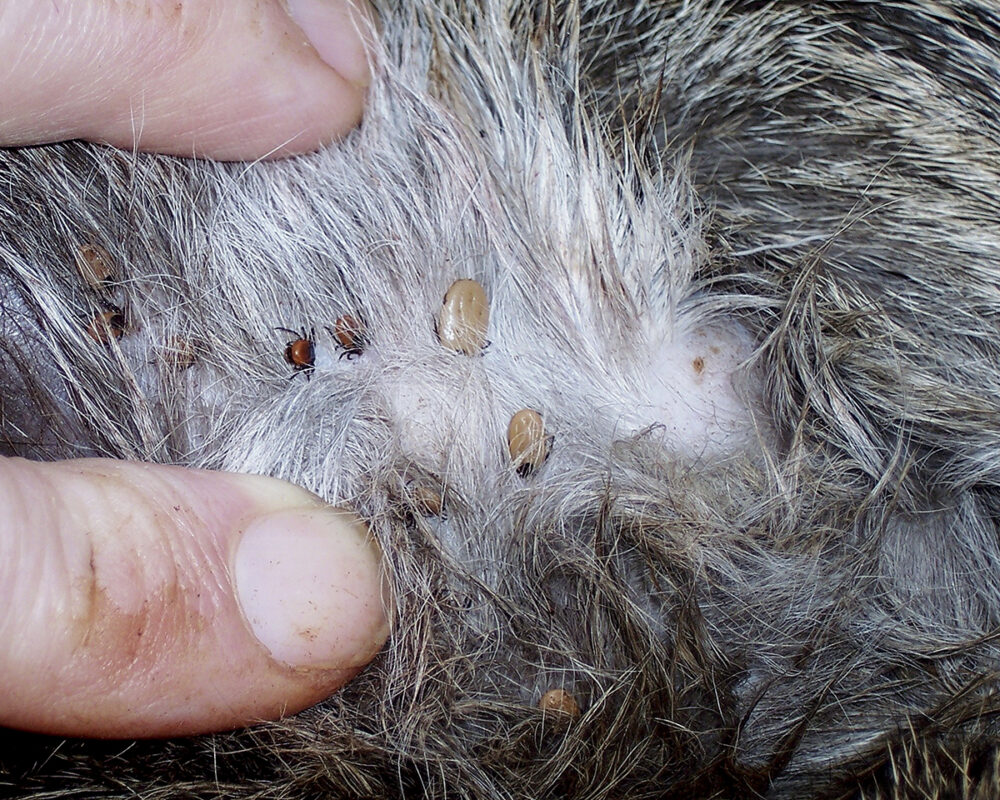
This white-tailed deer has a multitude of ticks on its face and ears. Photo by Shutterstock
By Dr. Leonard Lee Rue III
According to the statistics put out by the Center for Disease Control, there are about 30,000 new cases of Lyme disease reported each year, throughout the northeastern portion of the United States. Other scientific organizations say the number of new cases is closer to 300,000, as many new cases are not reported and are often improperly diagnosed in the first place.
Most everyone has been told or has read that the main sign of infection is the appearance of a large red bull’s eye marking at the bite site. Today we know that in many of the cases of infection there is no sign of the bull’s eye marking. Another myth was that if a person was started on the proper antibiotic regiment within a few days of getting infected, Lyme disease would be completely stopped and eliminated. The latest research has shown that for many folks that have had the infection the disease never disappears from the body but lies dormant and can become active at any time.
The first time I ever heard of Lyme disease, which is named after Lyme, Connecticut, from the area where the disease was first properly identified, was in the early 1980s. The disease is spread by the black-legged deer tick (Ixodes scapularis) to humans when a person is bitten by the tick. The bacteria (Borrelia burgdorferi) that causes the disease was named after Willy Burgdorfer, who first isolated the bacteria.
The disease can cause very serious health problems, such as extreme fatigue, headaches with neck stiffness, swelling of joints and memory loss. When the ticks first clamber aboard a human they are about the size of the period at the end of this sentence and so it is easy for them to escape early detection. After embedding themselves in the human’s skin, they quickly drink in blood and become hugely large for having been so small just a matter of hours ago.
In drinking the blood, the ticks inject a solution into the blood to prevent it from clotting, just as mosquitoes do. This is how ticks carrying the Lyme bacterium in their system infect humans and other species.
Although deer are represented as being such a threat as carriers of infected ticks, it is the white-footed mice, other small animals and some birds that are responsible for doing the most to spread the bacterium. If the six-legged tick larvae are not discovered and removed after getting a supply of blood, they drop off, molt, and become eight-legged nymphs and then adults. After feeding again on a host species, the females breed and drop off of their host, lay their couple of thousand eggs in the soil, and die. The eggs lie in the soil over the winter where they hatch out in the early spring ready to start another life cycle.

This young black bear has a heavy infestation of ticks. Animals living in the wild are exposed to ticks throughout the year.
About 1.5 percent of the people who are bitten by ticks contract the disease. During the time between 1950 and 1970, I was a Deputy New Jersey Conservation Officer, serving under Warden Robert Burns. Bob had contracted Lyme disease before it was known and thus had no recourse to the antibiotics that may have helped him control the infection. Bob retired from the warden force after serving for 27 years because the disease crippled him so badly that he spent the rest of his life in a wheelchair.
Thank God, I have never been infected with Lyme disease in spite of spending most of my life in the field living with, photographing and studying the white-tailed deer. I do want to mention that I think the main reason I have not been bitten by ticks is that I thoroughly soak my pants, shoes and socks with Permethrin insect repellent each spring as soon as the snow has melted. It is a practice that I recommend to everyone. A few years ago, I was teaching a photography class in Iowa. We were walking in a field and within 10 minutes time, most of my students had ticks crawling on them, while I was tick-free because of my protective clothing. I never wear shorts if I am going to be outdoors in any grassy area.
Read more about how to prevent tick bites while in the outdoors in “Bull’s Eye! Aim for Prevention” from a past issue of Virginia Wildlife magazine.
Lyme disease is most heavily concentrated in the Northeastern and Mid-Atlantic states but has expanded its range to cover the entire United States and is spreading north, into Canada. In fact, due to the warmer winters being experienced over our continent, the moose population has drastically declined in Minnesota and Maine. More ticks are surviving over the winter and are weakening the moose by feasting on their blood.
The white-tailed deer is a host to many of the ticks, and it has been proven that in areas of high infestations of the disease, the reduction of deer in the area does lessen the spread of Lyme. Through personal correspondence I had contact with Kevin Kelly, who had shot a doe near Halifax, Pennsylvania. He estimated the deer had at least a thousand ticks on just its head and neck. He removed 14 ticks from just one square inch of skin inside the deer’s ear. Despite that heavy infestation, the deer was fat and in good overall condition.

The whitetail-tailed deer is a host to many ticks. The author had contact with Kevin Kelly, who shot a doe near Halifax, Pennsylvania. Kelly estimated the deer had at least a thousand ticks on just its head and neck. Photo by Kevin Kelly
I had never heard of any animal carrying that many ticks and surviving. A deer’s ears and nose areas are practically hairless during the summer months and both sites make great targets for ticks, mosquitoes and biting flies. The deer frequently groom by licking around each other’s ears. I can’t say for sure they are removing ticks while doing so but the possibility is good.
Ticks are also responsible for many other types of human diseases such as Ehrlichiosis, Babesiosis, relapsing fever, Rocky Mountain spotted fever, tularemia and others. I did not know that the problems created by tick diseases had grown so pervasive and destructive till I heard that some of my friends who had had Lyme were going to a local Lyme Support Group. Like all of the support groups, the members tell of their many problems and get support from the group and the latest information which may help them better cope with their problems. If Lyme has affected you, finding a support group can help.
Dr. Leonard Lee Rue III is considered to be one of the foremost authorities on white-tailed deer in the country, having authored 31 books and more than 1,400 magazine articles and columns about whitetails.
©Virginia Deer Hunters Association. For attribution information and reprint rights, contact Denny Quaiff, Executive Director, VDHA.



